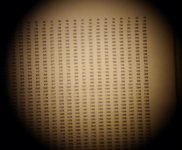John Russell
Well-known member
There is often confusion between astigmatism of the eye and astigmatism as an aberration in an optical instrument, so I thought I would attempt an explanation. It has even been suggested that one could cancel out the other but this is not the case. I stand open to correction for the following.
Astigmatism of the eye is caused by a difference in the radius of curvature of the cornea or lens in different planes. The planes of maximum and minimum radii of curvature would be spaced at around 90° and would result in point sources being focussed on the retina as short lines. Astigmatism of the eye can be corrected with cylindrical lenses.
Astigmatism as an optical aberration is somewhat more complicated. If we consider an objective lens that has been perfectly corrected for spherical aberration then any "rays" from a point source on the optical axis will be focussed to a point behind the lens on the optical axis. If however the point source is near the field edge an astigmatic objective would be unable to focus all rays in a flat (or curved) plane.
Considering a point source at the right hand edge of the field, alll rays in the tangential (right to left) plane will be focussed to a point and all rays in the sagittal plane (top to bottom from the same right hand source) will be focussed to a point, but the tangential and sagittal focal points will not be coincident.
Astigmatism in a binocular or scope can be seen if one tries to focus on a grid pattern at the field edge. It will be possible to achieve acceptable sharpness of either the vertical or horizontal lines, but not both simultaneously.
One could consider astigmatism as a type of field curvature. It's just that the tangential and sagittal focal planes have different radii and there are theoretically four possibilities. Both could have positive curvature, both negative, or one could be negative and the other positive.
John
Astigmatism of the eye is caused by a difference in the radius of curvature of the cornea or lens in different planes. The planes of maximum and minimum radii of curvature would be spaced at around 90° and would result in point sources being focussed on the retina as short lines. Astigmatism of the eye can be corrected with cylindrical lenses.
Astigmatism as an optical aberration is somewhat more complicated. If we consider an objective lens that has been perfectly corrected for spherical aberration then any "rays" from a point source on the optical axis will be focussed to a point behind the lens on the optical axis. If however the point source is near the field edge an astigmatic objective would be unable to focus all rays in a flat (or curved) plane.
Considering a point source at the right hand edge of the field, alll rays in the tangential (right to left) plane will be focussed to a point and all rays in the sagittal plane (top to bottom from the same right hand source) will be focussed to a point, but the tangential and sagittal focal points will not be coincident.
Astigmatism in a binocular or scope can be seen if one tries to focus on a grid pattern at the field edge. It will be possible to achieve acceptable sharpness of either the vertical or horizontal lines, but not both simultaneously.
One could consider astigmatism as a type of field curvature. It's just that the tangential and sagittal focal planes have different radii and there are theoretically four possibilities. Both could have positive curvature, both negative, or one could be negative and the other positive.
John





